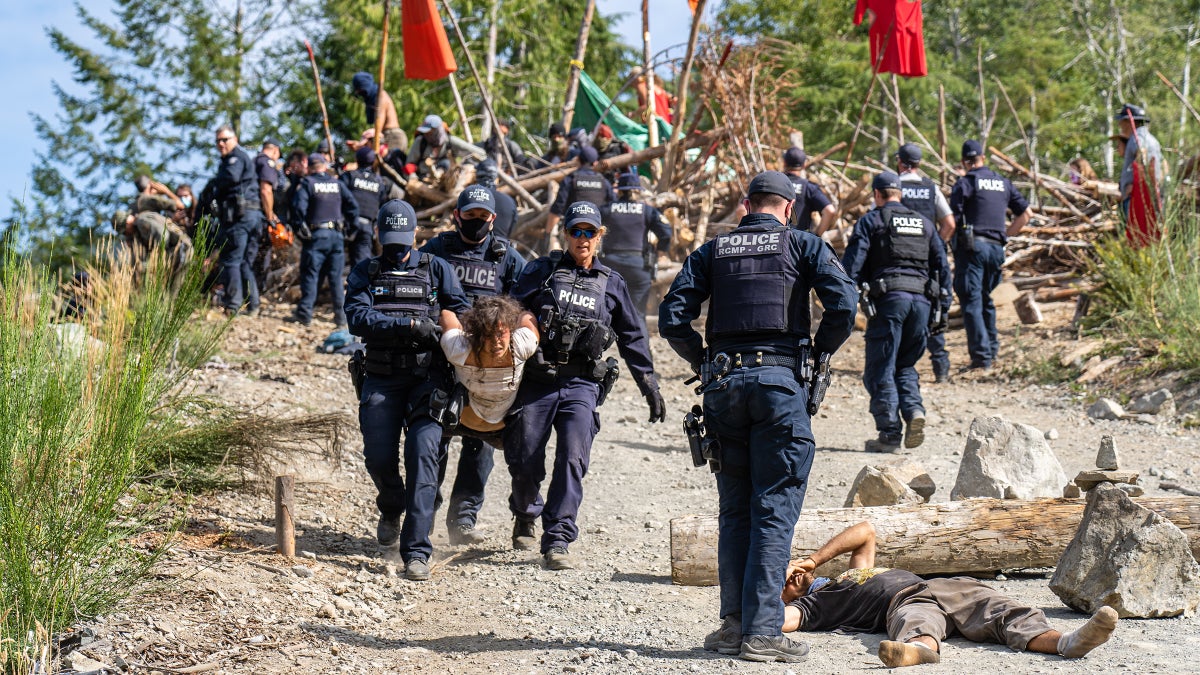
On September 28, a ruling by the British Columbia Supreme Court effectively removed police forces from the front lines of the Fairy Creek blockades, a 14-month-long act of civil disobedience dedicated to protecting old growth from logging in and around the Fairy Creek watershed on southwestern Vancouver Island.
The court denied the application of the Teal Jones Ltd. timber company to extend an injunction order against protestors interfering with logging. The original injunction authorized the Royal Canadian Mounted Police (RCMP) to arrest and remove all demonstrators, peaceful or otherwise. Since enforcement began in May 2021, police have arrested more than 1,100 people, making this the largest act of civil disobedience in Canadian history.
Shortly after Justice Douglas Thompson handed down the court’s decision, the grassroots organization that started the protests, the Rainforest Flying Squad, posted triumphantly on Instagram: “Today is a day for celebration. Dancing has broken out…and we are already reoccupying the gravel pit at Fairy Creek HQ.”
Kathleen Code, a spokesperson for the Rainforest Flying Squad, wrote an email to Outside stating that after the ruling, the RCMP packed up and left its posts at Fairy Creek. The next day, September 29, the “cop-car parade” that usually deploys each morning from the local RCMP detachment never came. “We’re not sure if the current withdrawal is a permanent situation or not,” Code wrote.
The ruling was made amid escalating tension at the blockades, with police accusing protestors of using more extreme and sophisticated techniques, like building 30-foot structures for protestors to sit in, and protestors claiming increased police aggression and violence. In August, videos surfaced of RCMP officers pepper-spraying a seemingly peaceful group of protestors and appearing to beat a man after they dragged him to the ground.
Fairy Creek is located on the unceded lands of the Pacheedaht First Nation, and the RCMP’s alleged use of unreasonable force has been traumatic for the movement’s many Indigenous and BIPOC members, who are more likely to suffer police violence.
It’s important to note that the court’s judgement, while a win for activists, does not prevent police from arresting those found engaging in criminal offenses, which could include protestors involved in some of the more extreme blockade measures that have been taken to date, like digging trenches in logging roads.
Also, Teal Jones still holds the rights to log old growth in Fairy Creek and the surrounding area, known in the timber industry as Tree Farm License 46 (TFL 46). Rob Shaw, a political correspondent at the Vancouver Island–based CHEK News, tweeted on September 29 that Teal Jones will appeal the court decision, and that the company intends to continue logging.
The B.C. government, despite promising to protect old-growth forests during the last election cycle, in October 2020, has yet to permanently protect Fairy Creek or the remaining 2.7 percent of high-productivity old growth—giant trees that support local biodiversity and global carbon sequestration—across the province. In the court ruling, Justice Thompson declined to weigh in on matters of right and wrong when it came to destroying what he called a “rare and irreplaceable ecosystem in the context of an existential environmental and climatological crisis,” essentially lobbing the ball back to politicians to fulfill their constitutional responsibilities.
Thompson acknowledged that the RCMP had at times acted out of line, “showing disquieting lapses in reasonable crowd control.” But for the most part, he wrote, interactions between protestors and police were respectful and nonviolent. His reasons for denying the application to extend the injunction were due to the RCMP’s failure to uphold civil liberties during its enforcement tactics, including illegally restricting access to the injunction area and impairing freedom of the press.
“One journalist who has reported on all manner of police events in Canada and elsewhere … deposed that the level of police restriction on journalist movement in TFL 46 was familiar to him from his work in China where he was accompanied by police who decided what he was allowed to see. In every other democratic society this journalist has worked in, he has been allowed to do his job without police escorts and exclusion zones,” Thompson wrote.
Thompson also rebuked police working on the Fairy Creek blockades for removing individual identification, like name tags, and for continuing to wear thin blue line patches, which are considered by some First Nations as symbolic of a history of RCMP involvement that enforced policies resulting in the genocide of Indigenous peoples.
“It might be argued that this is ‘just a patch, just a symbol.’ But we all know the impact that symbols can have,” he wrote. “I am certain that RCMP commanders know that these ‘thin blue line’ patches are seen as provocative and insensitive by some of the citizens they serve.”
What happens next is still unclear. In the meantime, the Rainforest Flying Squad continues to invite “all those who recognize the vital importance of our remaining ancient rainforests to join us in protecting these forests now, and for future generations.”
The post New Ruling Ousts Police from Old-Growth Protests at Fairy Creek appeared first on Outside Online.
by abarronian via Outside Online
Comments